Teaching Your Dog to Jump...
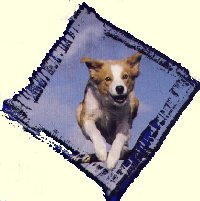 All Agility courses contain a number of hurdles so to do well it is essential that an Agility
dog enjoys and is reliable at jumping. The way a dog is introduced to jumping is very
important. Ruth Hobday shares her methods.
All Agility courses contain a number of hurdles so to do well it is essential that an Agility
dog enjoys and is reliable at jumping. The way a dog is introduced to jumping is very
important. Ruth Hobday shares her methods.
I see a lot of dogs with jumping faults that can be
traced back to the way the dog was taught to jump. The temptation to get the dog jumping his
full height as quickly as possible is great, but many problems can be caused by making the dog
jump too high before he has acquired confidence in jumping.
I see lots of dogs that run past or under hurdles, dogs
that crash into hurdles not really attempting to clear them, and many dogs that hesitate,
taking lots of little steps and gathering themselves before each hurdle. So many of these
faults could have been prevented with a more careful introduction to jumping.
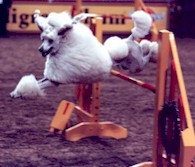 So how
do I go about introducing the dog to jumping. In the years since I wrote Agility is Fun -
Book 1, I have altered my method of training slightly. At that time I taught the dog to
jump using several poles on each hurdle and raising the height slowly until the dog could jump
his full height. Then when I felt that the dog was confident enough I lowered the height again
and taught him to jump a single pole. However, I now find it much better to use a single pole
right from the beginning. I find this way you end up with a much more reliable jumper and
single pole jumps rarely cause any problems. So how
do I go about introducing the dog to jumping. In the years since I wrote Agility is Fun -
Book 1, I have altered my method of training slightly. At that time I taught the dog to
jump using several poles on each hurdle and raising the height slowly until the dog could jump
his full height. Then when I felt that the dog was confident enough I lowered the height again
and taught him to jump a single pole. However, I now find it much better to use a single pole
right from the beginning. I find this way you end up with a much more reliable jumper and
single pole jumps rarely cause any problems.
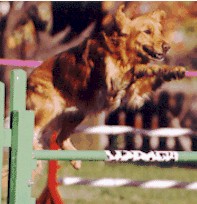 Lesson One
Lesson One
This then is how I teach a dog to jump. Set out a straight line of three or four hurdles placed
about eight paces apart each with a single pole set at 6-12 inches depending on the height of
the dog. A very tiny dog will need it lower still.
With the dog on the lead - use a plain collar not a check
- and working on the side the handler is most used to, get both the handler and the dog to jump
the first hurdle. If this is successful, let the handler and dog carry on over the other
hurdles.
There are several points to watch:-
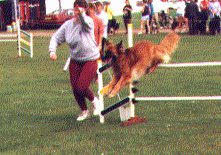
- Decide what command the handler is going to use and
give this about a yard from the jump.
- Tell the handler to go steady - it isn't necessary to
run at this stage.
- Keep the lead fairly short so that it keeps the dog in
the centre of the jump.
- Remember to praise the dog after each jump but don't
make a fuss of the dog if he runs by or pushes under. So many new handlers praise in the
wrong place. Remember the dog lives in the present and praise given to reassure a dog who has
run past a jump can be easily misinterpreted by the dog. If the dog goes wrong don't tell him
off, simply don't praise him, do it again and if successful give lots of praise.
As soon as the handler and dog have successfully
completed this, place the dog on the handler's other side and repeat the row of hurdles with
the handler still stepping over with the dog. I find the earlier you start the dog working on
both sides the better. However just occasionally you may get a dog who has done so much work
always on the left that he gets very upset if asked to work the other side. Although having a
dog that will work either side is really essential for Agility now it is not worth upsetting
the dog. It is more important to get him jumping happily, then you may be able to try again to
get him to work on the right. With the majority of dogs there is no problem.
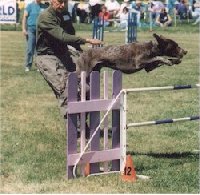 Once the dog is happily doing this, I repeat it with the handler keeping to the side of the
hurdle. While the dog is working on the lead, it is easier to use hurdles with uprights instead
of wings which tend to get in the way. Also the handler can stay closer to the dog who is then
less likely to run past the wing.
Once the dog is happily doing this, I repeat it with the handler keeping to the side of the
hurdle. While the dog is working on the lead, it is easier to use hurdles with uprights instead
of wings which tend to get in the way. Also the handler can stay closer to the dog who is then
less likely to run past the wing.
This is all I try to achieve in the first lesson. The
number of times you do the line of jumps depends on the individual dog. It is important to keep
the dog happy and stop before he gets bored or tired.
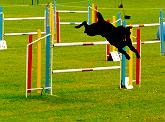 More
about jumping More
about jumping
I always use a row of hurdles so that the dog begins to realise that agility obstacles are
strung together and doesn't get into the habit of stopping after each. I use a toy as a reward
giving the dog a game at the end of the row of jumps. At this stage I always walk back to the
start and don't let the dog come back over the jumps he has just done.
I continue this straight line work until the dog gets the
idea of looking ahead for the next jump. The dog can then progress to working large circles of
jumps. I don't begin to teach turns until the dog is going on well.
The height of the jumps will depend on each dogs
progress. I move the height up fairly slowly until it is about 6 inches below the dogs full
height. I then leave the dog at this height for several weeks or even months until he is really
confident at jumping.
I encourage the handler to try without the lead as soon
as possible but am always prepared to put the lead back on if the dog starts to run past jumps.
How soon you can manage without the lead often depends on how good the handlers general control
is. It often helps for the handler to go back to jumping the hurdles with the dog when first
removing the lead.
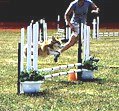 I never rush a dog into jumping his full height. I find if you wait until the dog is really
confident and happy jumping six inches lower he will hardly notice that extra six inches when
you finally ask him to do it. Lots of practise and encouragement over simple patterns of jumps
will help the dog to gain this confidence. Give lots of praise for success and achieve forward
movement before tackling tight turns.
I never rush a dog into jumping his full height. I find if you wait until the dog is really
confident and happy jumping six inches lower he will hardly notice that extra six inches when
you finally ask him to do it. Lots of practise and encouragement over simple patterns of jumps
will help the dog to gain this confidence. Give lots of praise for success and achieve forward
movement before tackling tight turns.
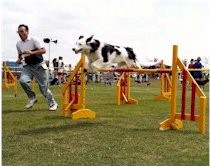 Once
the dog has realised that Agility obstacles are strung together he will start to look or the
next obstacle. I feel that it is so important to get this forward movement before teaching
tight turns. It is so easy to actually teach a dog to circle and flap around in front of the
handler, getting frustrated, getting in the way and wasting valuable time. Repeated sharp turns
before the dog has the idea of forward movement quickly causes this fault. Once
the dog has realised that Agility obstacles are strung together he will start to look or the
next obstacle. I feel that it is so important to get this forward movement before teaching
tight turns. It is so easy to actually teach a dog to circle and flap around in front of the
handler, getting frustrated, getting in the way and wasting valuable time. Repeated sharp turns
before the dog has the idea of forward movement quickly causes this fault.
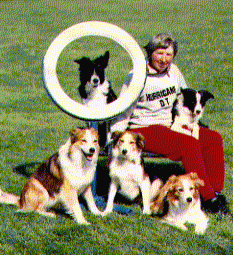 About the author...
About the author...
Ruth Hobday, pictured (left) with her canine family, runs her own agility training school -
Hurricane Dog Training situated in Shropshire. She visits agility clubs as a guest instructor
both in the UK and abroad. She also judges and competes.
Ruth's new book Agility Fun - The Hobday Way (Vol. 3)
Lessons for Beginners is now available. It contains more than 150 exercises and variations,
focusing on discrimination, teaching turns and teaching forward movement as well as 24 courses
with suggestions for many more sequences.
Available from Ruth Hobday,
Willow Batch, Carding Mill,
Church Stretton, Shropshire SY6 6JG.
Tel. 01694-723126
Price: £18.50 plus £2.50 (p & p).
Photos of Ruth Hobday source: Russell Fine Art
|